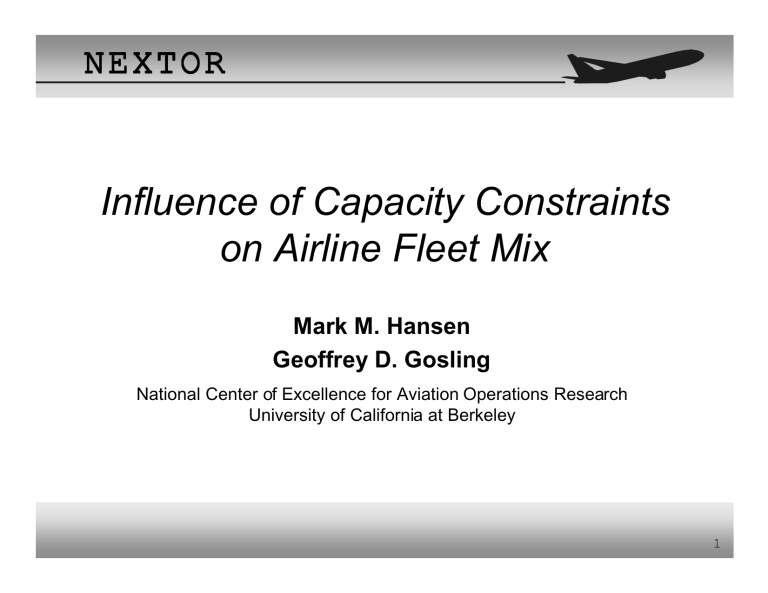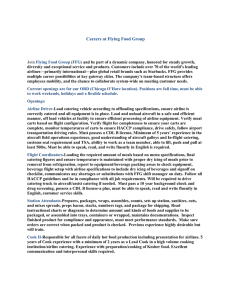Influence of Capacity Constraints on Airline Fleet Mix N N E
advertisement

NEXTOR Influence of Capacity Constraints on Airline Fleet Mix Mark M. Hansen Geoffrey D. Gosling National Center of Excellence for Aviation Operations Research University of California at Berkeley 1 NEXTOR Study Objectives Q Examine recent trends in aircraft size and market composition at LAX Q Assess the prospects for accommodating growth in travel demand through the use of larger aircraft ¥ Analyze impact of delays and capacity constraints on aircraft size and loads ¥ Analyze operational impacts of current fleet mix Q Assess policy implications 2 NEXTOR 70 Passengers (million) 60 50 International 40 30 Domestic Air Carrier 20 10 0 1970 Regional Airline 1975 1980 1985 1990 1995 Year 3 NEXTOR 800 Aircraft Operations (000) 700 International 600 500 400 Domestic Air Carrier 300 200 100 0 1970 Regional Airline 1975 1980 1985 1990 1995 Year 4 NEXTOR Passengers per Operation 140 120 100 80 60 Air Carrier Regional Airline 40 Total 20 0 1970 1975 1980 1985 1990 1995 2000 Year 5 NEXTOR Regional Airline Markets 6 Sp rin gs 350 250 Ca rls ba d Sa nJ os Or e an ge Co un ty M on te Sa re nL y uis Ob isp o Ba ke rs fie ld Pa lm Fr es no Sa nD ieg Sa o nta Ba rb ar a Enplaned Passengers (000) NEXTOR 450 400 1988 300 1998 200 150 100 50 0 7 NEXTOR Major Western U.S. Markets 8 n an en ty d to Ci tle se 1,400 rtl am ke at Jo er nd x 1,800 Po cr La Se Sa la ni nv ak oe De O Ph s co ga cis Ve an s Fr Sa lt n Sa Sa La Segment Traffic (000) NEXTOR 2,000 1988 1,600 1999 1,200 1,000 800 600 400 200 0 9 NEXTOR Changes in Average Aircraft Size Seats Destination 1988 1999 Las Vegas San Francisco Phoenix Oakland Denver San Jose Seattle Salt Lake City 131 142 128 118 175 117 152 166 136 130 131 132 187 130 144 184 Sacramento Portland 117 135 132 136 Overall 136 139 10 NEXTOR Market Tren ds LAX-Seattle 250 1,000 Segment Traffic 900 Average Aircraft Size 800 200 Average Load Factor Traffic (000) 700 150 600 500 100 400 300 Average Aircraft Size (seats) Load Factor (percent) Market Traffic 50 200 100 0 0 1988 1989 1990 1991 1992 1993 1994 1995 1996 1997 1998 1999 Year 11 NEXTOR Market Share Tren ds LAX-Seattle 100 250 AS Market Share 90 PS/US Market Share 80 200 Market Share (percent) UA Market Share 70 AS Average Aircraft Size UA Average Aircraft Size 60 150 50 40 100 30 20 Average Aircraft Size (seats) DL Market Share 50 10 0 0 1988 1989 1990 1991 1992 1993 1994 1995 1996 1997 1998 1999 Year 12 NEXTOR Airline Response to Delay 13 NEXTOR Statistical Modeling of Average Aircraft Size and Load Q Studied flight segments involving 18 large East and West Coast airports Q Regressed average aircraft size and passenger load against ¥ ¥ ¥ ¥ ¥ Distance Density (pax per day) Concentration (HHI of airline traffic shares) Average arrival delay at endpoint airports Slot control status 14 NEXTOR Estimated Aircraft Size Elasticities % Increase High Density (>300 PPD) Low Density in A/C Size from 1% Increase in: 300 SM 1000 SM 2500 SM All Density 0.12 0.12 0.06 0.20 Concentration 0.13 0.19 0.21 0.12 Delay -0.38 0.87 -Adj R2 0.46 0.56 0.56 0.47 15 NEXTOR Operational Impacts of Current Fleet Mix 16 NEXTOR During Peak Periods, Flights Generate Significant Incremental Delays Incremental Delay Impact (AC-Hrs) 3.50 3.00 2.50 2.00 Small Large 1.50 B757 Heavy 1.00 0.50 0.00 0:00 2:00 4:00 6:00 8:00 10:00 12:00 14:00 16:00 18:00 20:00 22:00 0:00 Scheduled Arrival Time 17 NEXTOR Delay Impact Ratio (DIR) Q Weighs delay impact against convenience Q Numerator is congestion delay impact (CDI) of a flight (in seat-hrs) Q Denominator is extra schedule delay if flight did not occur, and passengers had to take previous flight from same origin on same airline (SDI) Q Any flight with DIR>1 is of dubious social value 18 NEXTOR Some Flights Have Very High DIRs Flight US3 4759 US3 4734 US3 4707 US3 4793 UA3 5218 UA3 5220 OE 7338 UA3 5222 OE 7017 UA3 5224 US3 4789 UA3 5468 Type J31 J31 J31 J31 EM2 EM2 J31 EM2 J31 EM2 J31 EM2 Seats 18 18 18 18 30 30 18 30 18 30 18 30 Origin SAN FAT SAN SAN SAN SAN OXR SAN SNA SAN SAN PSP Time of Departure 9:50 9:45 9:35 9:10 9:00 9:30 9:55 10:00 9:45 10:30 20:10 9:05 Previous Flight Flight Time of Number Departure 4707 9:35 4729 9:25 4793 9:10 4768 8:30 5216 8:30 5218 9:00 7336 8:50 5220 9:30 7015 8:30 5222 10:00 4741 19:25 5466 8:05 SDI 5 6 8 12 15 15 20 15 23 15 14 30 CDI 247 282 292 398 425 261 308 228 338 217 191 409 DIR 55.0 47.0 38.9 33.2 28.4 17.4 15.8 15.2 15.0 14.5 14.2 13.6 19 NEXTOR Policy Implications Q Rationale for intervention ¥ Economic efficiency ¥ Airport development costs ¥ Consumer protection Q Intervention strategies ¥ Voluntary programs ¥ Pricing ¥ Size / frequency regulation 20 NEXTOR Conclusions Q No significant increase in average aircraft size in LAX markets over past ten years ¥ Little overall increase by large airlines ¥ Significant increase by regional airlines, offset by replacement of large airline service Q Modest potential for self-correction ¥ Delay costs alone may not be enough to offset the competitive advantages of flight frequency Q Airport intervention should be framed in the context of long-term development strategy 21 NEXTOR Acknowledgement Q The research described in this presentation was supported by the Los Angeles World Airports 22



